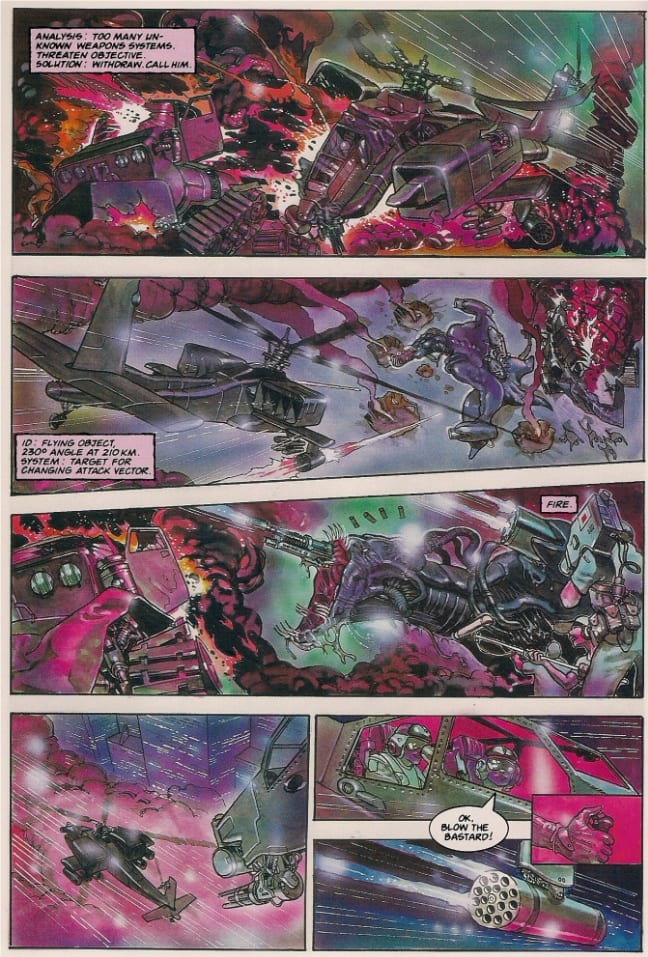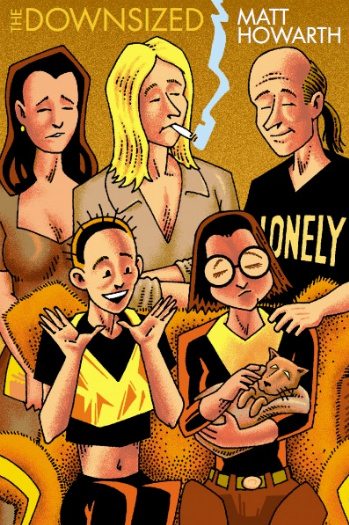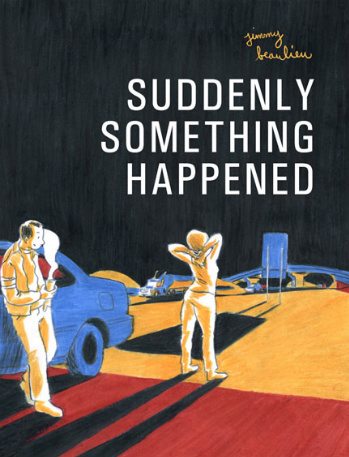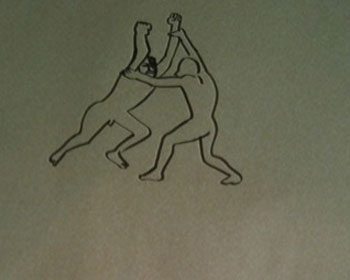I recently enjoyed this Alex Boney post over at the Panelists on a relatively obscure Eddie Campbell project: Catalyst: Agents of Change, one of the shorter-lived exhibits from Dark Horse's early '90s experiment in shared-universe superheroes, Comics' Greatest World. That stuff started out specifically in 1993, the year Image Comics had really started making waves with their creator-owned superhero comics, many of which swiftly expanded into work-for-hire projects with the originating artist as the hiring agent. More than anything else happening at the time in the predominant genre, this rapid mutation into a muscled genre sprawl got everyone in its peer circle frightened and excited, leading publishers like Dark Horse to flip its motto at the time ("The World's Greatest Comics!") into something more in keeping with the superhero hits of the day. It happened around the same time as the launch of the publisher's Legend imprint, which emphasized creator ownership; frankly, Dark Horse had published a number of creator-owned works by that time, and few of the Legend titles swapped characters among artists in the way the Image superhero comics did, but branding an association of creators was no doubt a clever move in marketing terms.
Naturally, today we know of the particular success of Mike Mignola's Hellboy, which (again) expanded into its own line of comics, if not in quite as scattered a manner as the Image books; Mignola retains considerable supervisory authority over his family of comics, taking some plotting credit on almost everything and often 'scripting' in thumbnail form, manga-style, to assure a certain visual quality across the board while stopping short of enforcing a house look. To my mind, this is a truer extension of the Image type of visually-oriented super-person comics -- and the Image comics were really the last time superhero comics as a genre were defined in considerable part by their visual characteristics -- than most of the actual Image franchises, which took the notion of creative freedom simply as 'doing whatever you want,' which is logical and true, if not necessarily conductive to good or consistent work, or even any sort of work at all. And the less said of Catalyst: Agents of Change and the Comics' Greatest World experiment the better; I can only agree with Boney in his post that "I’m not sure it would have been a good fit for any writer coming in from independent or underground comics (or from superhero writing, for that matter)," and Campbell himself down in the comments that "It wasn’t really Dark Horse’s thing either."
However, I was reminded of a different Dark Horse release of 1993 that fit so much better with the tenor of the times, despite lacking the branding of a superhero 'universe' or a focus-promoted squad of creators; instead, it was just one random Dark Horse miniseries out of many in those days, come and gone with little notice. I'm referring to Matthias Schultheiss' Propellerman, an eight-issue project that ran bimonthly in '93 and '94. And despite coming from a literally foreign artist, it was very much a superhero comic of those years.
Schultheiss had been working on the German comics scene for over a decade by then, although his appearances in English had been sporadic. His three-volume science-fiction album series Bell's Theorem had been published by Catalan Communications from 1987-89 at almost the same time as its German release (Die Wahrheit über Shelby), while a Charles Bukowski adaptation, A Couple of Winos, saw release from Fantagraphics in 1991. He was in Heavy Metal (of course!) the same month Propellerman debuted, but the later comic is unique in that it does not appear to have any German or French publishing basis - to my knowledge, it was squarely an attempt to make an American comic from a place of appreciation of early '60s superhero comics, particularly the angst-ridden types of early Marvel.
It didn't look very much like the House of Ideas, though, unless you're pushing the timeline up to the salad years of mutant comics under the future Image founders. One particular issue sports an ad for Hero Illustrated splashed with Whilce Portacio's Wetworks art, and its startling to see the commonalities between both artists' muscular, grimacing approaches. Schultheiss was not a nostalgist, nor, it should be said, a particularly fine writer; the Propellerman saga concerns an amnesiac waking up encased in a shock trooper battle suit of second skin, driven by obscure desires to fly his glider through a glittering tinsel city of the future to eventually do battle with a escaped mass of monster skin and metal gun barrels -- a forbidden experiment of a virtual reality corporation run by an Oedipal mad scientist dressed as a cyber-Caligula -- and eventually make friends with the usual ragtag team of society's renegades. There's also a rather steampunk suit of Ancient Egyptian mecha armor, a wistful girl street gang leader, and plenty of intrusive expository news broadcasts a la The Dark Knight Returns, also not an oft-cited influence on Eurocomics of the era.
But like many of the Image comics, Schultheiss emphasized noisy-big visual spectacle. Propellerman differs from the rest of his color work in English in employing a bolder coloring scheme, thick and heavy with shiny notes and airbrushy detailing, with individual scenes generally bent toward serving a particular color scheme. Schultheiss eventually began employing a credited art assistant, one Stéphane Séverac, and later issues evidence even harsher, saturating colors, sometimes to the point of compensating for dropped background details - apparently they were playing an American deadline game as well. Tanino Liberatore looms heavily over Schultheiss' drawing, particularly his putty-like humanoid figures, which gives the whole thing the odd sensation of RanXerox being played completely straight as a potential Cyberforce sparring partner. Certainly Schultheiss lacks Liberatore's sense of humor, though the blend of hesitantly molded character art and glowing color detail syncs well with Richard Corben's various above-ground comics efforts.
Indeed, if Propellerman suggests the underground coming up as much as X-Men artists breaking off -- Corben now enjoys a regular forum in the aforementioned Hellboy universe -- it might be from Schultheiss keeping an eye on comics as a global force. His renown, as it was, came from pursuing international publishing avenues, and as a result his 'American' comic, while gleefully informed by contemporary superhero smashers of the period, seeks common ground among diverse approaches. There's more than a little Japanese to Propellerman, from an obligatory samurai supporting hero to the manga-like funny asides from supporting cast members standing to the side of a panel - and those shimmering future cityscapes are as anime cyberpunk as can be! There's a casual, unconcerned 'adolescent maturity' to the action, filled with tossed-off profanities and no-big-deal gore that belies a relaxation with sensational elements I associate with Japanese nerd entertainments of the time; oddly, this makes the work seem as much of today as the Image Revolution, now that American comics have more thoroughly kneaded in an international outlook.
I can't say I know how Propellerman ends; I'm missing three issues, including the last two. Fascinating as it is, the particulars of its execution are uneven, particular in its wordy, derivative plotting and script. It's the kind of thing I'm glad to find in back issue bins somewhere, as opposed to searching it out in complete form online; some comics work better where you find them in pieces, and revisit them occasionally. Schultheiss has likewise been erratic in visibility; his only subsequent English-language release was the 1997 Eros Graphic Novel (#10), Talk Dirty, translating an earlier European work. After Propellerman, he actually went to work in the manga industry, via the same Kodansha-sponsored international program that attracted Lewis Trondheim and Paul Pope. He later left comics entirely to go into television scriptwriting, a la Howard Chaykin, although last year saw the French and German releases of a new, nearly 300-page work, Le voyage avec Bill (Die Reise mit Bill); its premise involves a trip across America. I suspect the artist remains consistent, then, in perspective.
***
PLEASE NOTE: What follows is not a series of capsule reviews but an annotated selection of items listed by Diamond Comic Distributors for release to comic book retailers in North America on the particular Wednesday, or, in the event of a holiday or occurrence necessitating the close of UPS in a manner that would impact deliveries, Thursday, identified in the column title above. Not every listed item will necessarily arrive at every comic book retailer, in that some items may be delayed and ordered quantities will vary. I have in all likelihood not read any of the comics listed below, in that they are not yet released as of the writing of this column, nor will I necessarily read or purchase every item identified; THIS WEEK IN COMICS! reflects only what I find to be potentially interesting.
***
SPOTLIGHT PICKS!
The Downsized: Being the newest comic by Matt Howarth, longtime alternative comics veteran and creator of Those Annoying Post Bros. and Savage Henry. I primarily know of Howarth's work by reputation, so this particular spotlight is a means of focusing myself on a potential avenue of access. Yes, there's a utilitarian basis to this column! An AdHouse production, 80 pages. Preview; $6.95.
Suddenly Something Happened: Similarly, I only know of this 256-page Conundrum Press release through a review by Tom Spurgeon, who nonetheless offers up some nice-looking art samples and the promise of "a strong document in a small literature describing the subtle ways in which we all quietly grow up." It's the English-language debut of Quebec-based artist Jimmy Beaulieu, melding assorted French-language autobiographical stories with new work. Samples; $20.00.
--
PLUS!
Your Highness: Knight and Dazed: A 48-page Dark Horse media prequel tie-in thingy for the upcoming David Gordon Green motion picture, following hot on the heels of Geof Darrow's comics adaptation of All the Real Girls. (God, I wish that wasn't a lie.) Scripted by the movie's leading man and co-writer, Danny McBride -- also of Eastbound & Down, obviously -- with Jeff Fradley, who was second unit director on McBride breakthrough The Foot Fist Way. Pencils by Sean Phillips, although the inks and colors aren't giving him the look familiar to readers of Criminal or Incognito. Preview; $7.99.
Yo Gabba Gabba! Comic Book Time Vol. 1: In contrast, this tie-in to the children's television program takes the anthology route, with contributions by the likes of Mike Allred, Evan Dorkin, Sarah Dyer, J. Bone and others; $24.99.
Neon Genesis Evangelion Vol. 12: None of these projects, however, are at all likely to wind up in the same place as this infamous Yoshiyuki Sadamoto series, intended at the time of its 1995 launch to be a simple manga version of what eventually transformed into one of the defining anime television series of the '90s, and a still-controversial entry in giant robot history. Still lucrative too, as contemporary efforts to revise the series into a quartet of theatrical animation features continues. Through it all, for 16 years, Sadamoto -- a popular character designer and illustrator/animator in his own right -- worked slowly on the manga, by now yet another alternate vision of the plotline's action and nearing its conclusion. But how close is it? Viz's English editions are now caught up with the Japanese books, and the artist is scheduled to release some more serialized chapters this April; $9.99.
Gantz Vol. 16: Meanwhile, Hiroya Oku and his crack team of studio assistants/bank of computer equipment charge forward with more violence. The premise of Gantz sees a rotating team of recently-deceased common folk pressed into the service of an odd black orb, fighting off weird creatures for the sake of winning video game-like points. It's a lot of righteous trash, the kind of thing that's plainly self-aware and more than a little tongue in cheek about its sex & violence excess, though rarely moved to do anything more than embrace the most lurid aspects of everything as a statement of its individuality. A recent movie attempted to turn it all into a critique of action movie/superhero violence, but I'm not sure the source really supports that kind of reading; it all seemed half-cocked and empty, and quiet, when the secret ingredient should be FURY. Preview; $12.99.
Johnny Cash: I See a Darkness: I don't know if this ever appeared in Direct Market stores through Diamond -- which is not listing it as "offered again" or anything -- but it's a 2009 Abrams ComicArts edition of a 2006 book of Man in Black-related comics by German cartoonist Reinhard Kleist. Interview and samples; $17.95.
Xombi #1: This is one of DC's attempts at utilizing the Milestone superhero characters -- denizens of a separate superhero universe founded in that heady superhero year of 1993 by a number of black creators interested in expanding the in-story demographics of spandex genre comic books -- recently brought into ongoing DC continuity. Co-creator and writer John Rozum returns to his concept of a researcher made potentially immortal by nanotechnology, now drawn by the very fine Frazer Irving, a color-oriented digital worker with one of the most unique styles in front-of-Previews comic books. Preview; $2.99.
T.H.U.N.D.E.R. Agents #5: The current hot superhero revival series by high-profile genre comics writer-of-the-moment Nick Spencer, whose popular Image-published schoolhouse conspiracy mystery series Morning Glories, which I confess did not inspire me to read past its preview materials, also sees its eighth issue out this week. Notable for a sequence drawn by Ryan Sook, one of the nicer classically-styled comics illustration types active today; $2.99.
Deadpool MAX: A History of Violence: Huh, this looks to be a genuine bumper book, compiling several issues of a popular series into a fatter, lower-priced comic book for the benefit of those who missed out on the original printings. And there has been much chat over this David Lapham/Kyle Baker series, although I personally feel the initial three issues collected in here are dominated by Baker's visual style, plopping heavily caricatured, sometimes humorously stiff character images atop often loosely-drawn backgrounds blasted with color. It's funny art, wrenching a defiantly vulnerable feel out of digital stuff usually primed toward slick realism in its superhero peer group. Lapham's dialogue is considerably more uneven, although his understated characterization of the inescapable Deadpool character belies a certain darkness to his lampoon of Marvel superhero action as a colorfully eccentric tangent to authentically bloody American special ops activities; $4.99.
Dan Dare, Pilot of the Future: The Biography: Finally, your book-on-comics for the week - a 320-page Orion Publishing Group release by Daniel Tatarsky, purporting to relate the history of the long-lived Frank Hampson creation and Eagle, its originating anthology; $19.95.
--
CONFLICT OF INTEREST RESERVOIR: And speaking of commonalities with Spawn and Youngblood, Krazy & Ignatz 1919-1921: A Kind, Benevolent and Amiable Brick offers 176 pages of blood-drenched chrome and muscle carnage as you like it; $24.99. Note that Midtown Comics at least appears to be getting three more books by the same publisher: Jacques Tardi's early scratchwork outing The Arctic Marauder; Joe Daly's new Dungeon Quest Vol. 2; and the latest MOME, Vol. 21. Diamond ain't listing any of that, so keep your eyes peeled. Published by Fantagraphics Books: your home for new comics tip sheet columns that occasionally list publications by Fantagraphics Books.











